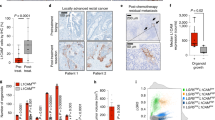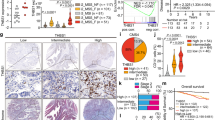Abstract
Inactivation of TGF-β family signaling is implicated in colorectal tumor progression. Using cis-Apc+/Δ716 Smad4+/− mutant mice (referred to as cis-Apc/Smad4), a model of invasive colorectal cancer in which TGF-β family signaling is blocked, we show here that a new type of immature myeloid cell (iMC) is recruited from the bone marrow to the tumor invasion front. These CD34+ iMCs express the matrix metalloproteinases MMP9 and MMP2 and the CC-chemokine receptor 1 (CCR1) and migrate toward the CCR1 ligand CCL9. In adenocarcinomas, expression of CCL9 is increased in the tumor epithelium. By deleting Ccr1 in the background of the cis-Apc/Smad4 mutant, we further show that lack of CCR1 prevents accumulation of CD34+ iMCs at the invasion front and suppresses tumor invasion. These results indicate that loss of transforming growth factor-β family signaling in tumor epithelium causes accumulation of iMCs that promote tumor invasion.
This is a preview of subscription content, access via your institution
Access options
Subscribe to this journal
Receive 12 print issues and online access
$209.00 per year
only $17.42 per issue
Buy this article
- Purchase on Springer Link
- Instant access to full article PDF
Prices may be subject to local taxes which are calculated during checkout







Similar content being viewed by others
Accession codes
References
Kinzler, K.W. & Vogelstein, B. Lessons from hereditary colorectal cancer. Cell 87, 159–170 (1996).
Moustakas, A. & Heldin, C.-H. Non-Smad TGF-β signals. J. Cell Sci. 118, 3573–3584 (2005).
Salovaara, R. et al. Frequent loss of SMAD4/DPC4 protein in colorectal cancers. Gut 51, 56–59 (2002).
Parsons, R. et al. Microsatellite instability and mutations of the transforming growth factor β type II receptor gene in colorectal cancer. Cancer Res. 55, 5548–5550 (1995).
Mori, Y. et al. Instabilotyping: comprehensive identification of frameshift mutations caused by coding region microsatellite instability. Cancer Res. 61, 6046–6049 (2001).
Takaku, K. et al. Intestinal tumorigenesis in compound mutant mice of both Dpc4 (Smad4) and Apc genes. Cell 92, 645–656 (1998).
Oshima, H., Oshima, M., Kobayashi, M., Tsutsumi, M. & Taketo, M.M. Morphological and molecular processes of polyp formation in ApcΔ716 knockout mice. Cancer Res. 57, 1644–1649 (1997).
Mueller, M.M. & Fusenig, N.E. Friends or foes–bipolar effects of the tumor stroma in cancer. Nat. Rev. Cancer 4, 839–849 (2004).
Coussens, L.M., Tinkle, C.L., Hanahan, D. & Werb, Z. MMP-9 supplied by bone marrow-derived cells contributes to skin carcinogenesis. Cell 103, 481–490 (2000).
Olumi, A.F. et al. Carcinoma-associated fibroblasts direct tumor progression of initiated human prostatic epithelium. Cancer Res. 59, 5002–5011 (1999).
Orimo, A. et al. Stromal fibroblasts present in invasive human breast carcinomas promote tumor growth and angiogenesis through elevated SDF-1/CXCL12 secretion. Cell 121, 335–348 (2005).
Lin, E.Y., Nguyen, A.V., Russel, R.G. & Pollard, J.W. Colony-stimulating factor 1 promotes progression of mammary tumors to malignancy. J. Exp. Med. 193, 727–739 (2001).
Friedl, P. & Wolf, K. Tumour-cell invasion and migration: diversity and escape mechanisms. Nat. Rev. Cancer 3, 362–374 (2003).
Bhowmick, N.A., Neilson, E.G. & Moses, H.L. Stromal fibroblasts in cancer initiation and progression. Nature 432, 332–337 (2004).
Pollard, J.W. Tumor-educated macrophages promote tumour progression and metastasis. Nat. Rev. Cancer 4, 71–78 (2004).
Seno, H. et al. Cyclooxygenase 2- and prostaglandin E2 receptor EP2-dependent angiogenesis in ApcΔ716 mouse intestinal polyps. Cancer Res. 62, 506–511 (2002).
Akashi, K., Traver, D., Miyamoto, T. & Weissman, I.L. A clonogenic common myeloid progenitor that gives rise to all myeloid lineages. Nature 404, 193–197 (2000).
Krause, D.S., Fackler, M.J., Civin, C.I. & May, W.S. CD34: structure, biology, and clinical utility. Blood 87, 1–13 (1996).
Zhao, X. et al. CCL9 is secreted by the follicle-associated epithelium and recruits dome region Peyer's patch CD11b+ dendritic cells. J. Immunol. 171, 2797–2830 (2003).
Yang, M. & Odgren, P.R. Molecular cloning and characterization of rat CCL9 (MIP-1γ), the ortholog of mouse CCL9. Cytokine 31, 94–102 (2005).
Chen, C.-R., Kang, Y., Siegel, P.M. & Massagué, J. E2F4/5 and p107 as Smad cofactors linking the TGFβ receptor to c-myc repression. Cell 110, 19–32 (2002).
Matsuo, S.E., Leoni, S.G., Colquhoun, A. & Kimura, E.T. Transforming growth factor-β1 and activin A generate antiproliferative signaling in thyroid cancer cells. J. Endocrinol. 190, 141–150 (2006).
Gao, J.-L. et al. Impaired host defense, hematopoiesis, granulomatous inflammation and type 1-type 2 cytokine balance in mice lacking CC chemokine receptor 1. J. Exp. Med. 185, 1959–1968 (1997).
Greaves, D.R. & Schall, T.J. Chemokines and myeloid cell recruitment. Microbes Infect. 2, 331–336 (2000).
Robinson, S.C. et al. A chemokine receptor antagonist inhibits experimental breast tumor growth. Cancer Res. 63, 8360–8365 (2003).
Janowska-Wieczorek, A. et al. Growth factors and cytokines upregulate gelatinase expression in bone marrow CD34+ cells and their transmigration through reconstituted basement membrane. Blood 93, 3379–3390 (1999).
Mook, O.R.F., Frederiks, W.M. & Van Noorden, C.J.F. The role of gelatinases in colorectal cancer progression and metastasis. Biochim. Biophys. Acta 1705, 69–89 (2004).
Markowitz, S. TGF-β receptors and DNA repair genes, coupled targets in a pathway of human colon carcinogenesis. Biochim. Biophys. Acta 1470, M13–M20 (2000).
Direkze, N.C. et al. Bone marrow contribution to tumor-associated myofibroblasts and fibroblasts. Cancer Res. 64, 8492–8495 (2004).
Garmy-Susini, B. & Varner, J.A. Circulating endothelial progenitor cells. Br. J. Cancer 93, 855–858 (2005).
Kaplan, R.N. et al. VEGFR1-positive haematopoietic bone marrow progenitors initiate the pre-metastatic niche. Nature 438, 820–827 (2005).
Wyckoff, J. et al. A paracrine loop between tumor cells and macrophages is required for tumor cell migration in mammary tumors. Cancer Res. 64, 7022–7029 (2004).
Lewis, C.E. & Pollard, J.W. Distinct role of macrophages in different tumor microenvironments. Cancer Res. 66, 605–612 (2006).
Kusmartsev, S. & Gabrilovich, D.I. Role of immature myeloid cells in mechanisms of immune evasion in cancer. Cancer Immunol. Immunother. 55, 237–245 (2006).
Han, I.-S. et al. Differentiation of CD34+ cells from human cord blood and murine bone marrow is suppressed by C6 β-chemokines. Mol. Cells 15, 176–180 (2003).
Balkwill, F. Cancer and the chemokine network. Nat. Rev. Cancer 4, 540–550 (2004).
Forssmann, U. et al. CKβ8, a novel CC chemokine that predominantly acts on monocytes. FEBS Lett. 408, 211–216 (1997).
Paglinawan, R. et al. TGFβ directs gene expression of activated microglia to an anti-inflammatory phenotype strongly focusing on chemokine genes and cell migratory genes. Glia 44, 219–231 (2003).
Scotton, C., Milliken, D., Wilson, J., Raju, S. & Balkwill, F. Analysis of CC chemokine and chemokine receptor expression in solid ovarian tumours. Br. J. Cancer 85, 891–897 (2001).
Bergers, G. et al. Matrix metalloproteinase-9 triggers the angiogenic switch during carcinogenesis. Nat. Cell Biol. 2, 737–744 (2000).
Collins, H.M., Morris, T.M. & Watson, S.A. Spectrum of matrix metalloproteinase expression in primary and metastatic colon cancer: relationship to the tissue inhibitors of metalloproteinases and membrane type-1-matrix metalloproteinase. Br. J. Cancer 84, 1664–1670 (2001).
Zavadil, J. & Böttinger, E.P. TGF-β and epithelial-to-mesenchymal transitions. Oncogene 24, 5764–5774 (2005).
Grady, W.M. et al. Mutation of the type II transforming growth factor-β receptor is coincident with the transformation of human colon adenomas to malignant carcinomas. Cancer Res. 58, 3101–3104 (1998).
Ishiguro, K., Yoshida, T., Yagishita, H., Numata, Y. & Okayasu, T. Epithelial and stromal genetic instability contributes to genesis of colorectal adenomas. Gut 55, 695–702 (2006).
Bhowmick, N.A. et al. TGF-β signaling in fibroblasts modulates the oncogenic potential of adjacent epithelia. Science 303, 848–851 (2004).
Oshima, M. et al. Loss of Apc heterozygosity and abnormal tissue building in nascent intestinal polyps in mice carrying a truncated Apc gene. Proc. Natl. Acad. Sci. USA 92, 4482–4486 (1995).
Oshima, H., Oshima, M., Inaba, K. & Taketo, M.M. Hyperplastic gastric tumors induced by activated macrophages in COX-2/mPGES-1 transgenic mice. EMBO J. 23, 1669–1678 (2004).
Brubaker, P.L. & Vranic, M. Fetal rat intestinal cells in monolayer culture: a new in vitro system to study the glucagon-like immunoreactive peptides. Endocrinology 120, 1976–1985 (1987).
Okabe, M., Ikawa, M., Kominami, K., Nakanishi, T. & Nishimune, Y. 'Green mice' as a source of ubiquitous green cells. FEBS Lett. 407, 313–319 (1997).
Mook, O.R.F., van Overbeek, C., Ackema, E.G., van Maldegem, F. & Fredericks, W.M. In situ localization of gelatinolytic activity in the extracellular matrix of metastasis of colon cancer in rat liver using quenched fluorogenic DQ-gelatin. J. Histochem. Cytochem. 51, 821–829 (2003).
Acknowledgements
We thank T. Hirai for sectioning the clinical samples. We also thank M. Okabe (Osaka University) for EGFP transgenic mice and P.M. Murphy (National Institute of Allergy and Infectious Diseases, US National Institutes of Health) for CCR1 knockout mice. This work was supported by a Grant-in-Aid for Scientific Research from the Ministry of Education, Culture, Sports and Technology of Japan (to M.M.T.).
Author information
Authors and Affiliations
Corresponding author
Ethics declarations
Competing interests
The authors declare no competing financial interests.
Supplementary information
Supplementary Fig. 1
Construction of cis-Apc/Smad4. (PDF 120 kb)
Supplementary Fig. 2
CD34+ CD31− cells. (PDF 273 kb)
Supplementary Fig. 3
Expression of CCL9. (PDF 46 kb)
Supplementary Fig. 4
Extent of immune cell infiltration. (PDF 483 kb)
Supplementary Fig. 5
Extent of CD34+ cell accumulation. (PDF 461 kb)
Supplementary Fig. 6
CD34+ cells also express MMP2. (PDF 221 kb)
Supplementary Table 1
Array data for chemokine mRNAs. (PDF 42 kb)
Supplementary Table 2
List of primer sequences. (PDF 29 kb)
Rights and permissions
About this article
Cite this article
Kitamura, T., Kometani, K., Hashida, H. et al. SMAD4-deficient intestinal tumors recruit CCR1+ myeloid cells that promote invasion. Nat Genet 39, 467–475 (2007). https://doi.org/10.1038/ng1997
Received:
Accepted:
Published:
Issue Date:
DOI: https://doi.org/10.1038/ng1997
This article is cited by
-
Notch signaling mutations increase intra-tumor chemokine expression and predict response to immunotherapy in colorectal cancer
BMC Cancer (2022)
-
Colorectal liver metastasis: molecular mechanism and interventional therapy
Signal Transduction and Targeted Therapy (2022)
-
High tumor budding is a strong predictor of poor prognosis in the resected perihilar cholangiocarcinoma patients regardless of neoadjuvant therapy, showing survival similar to those without resection
BMC Cancer (2020)
-
M2-like polarization of THP-1 monocyte-derived macrophages under chronic iron overload
Annals of Hematology (2020)
-
TRIM47 is up-regulated in colorectal cancer, promoting ubiquitination and degradation of SMAD4
Journal of Experimental & Clinical Cancer Research (2019)



